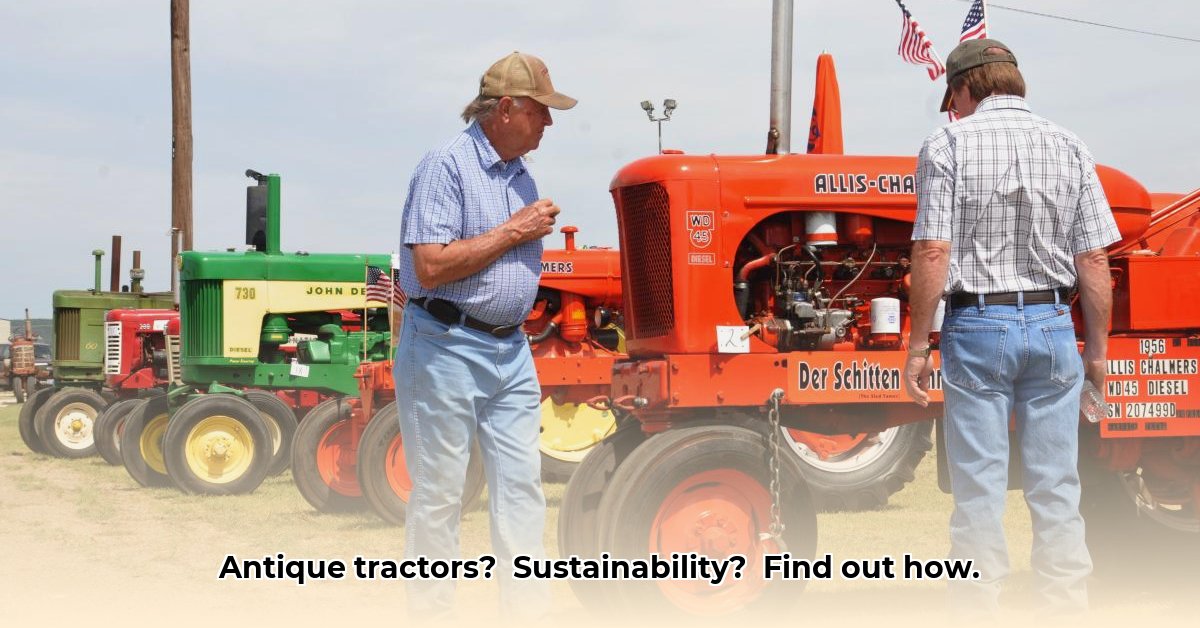
Antique Tractor Shows: More Than Just Nostalgia
Antique tractor shows, vibrant gatherings of gleaming metal and rumbling engines, offer a captivating glimpse into agricultural history. But these events hold a surprising key to a more sustainable future. The meticulous restoration of these machines reflects the core values of sustainable agriculture: resourcefulness, durability, and a commitment to longevity. This article explores the unexpected connection between antique tractor shows and the pursuit of environmentally conscious farming practices. Can these seemingly disparate worlds work together to cultivate a greener future? The answer, surprisingly, is a resounding yes. For more on antique tractor values, check out this resource.
A Deeper Dive into the Hobby and its Potential
The dedication of antique tractor enthusiasts is remarkable. Restoring these machines is a labor of love, requiring immense skill and patience. It's a testament to the enduring appeal of traditional craftsmanship, echoing the principles of sustainable agriculture, where repair and reuse are prioritized over constant replacement. But the potential for sustainability extends beyond the individual level. The collective power of this community offers a unique opportunity to promote and implement sustainable agricultural practices on a larger scale.
How can we effectively leverage this enthusiasm for a greener future? This is a question that requires collaborative effort and innovative solutions.
Bridging the Past and the Future: Challenges and Opportunities
While antique tractor shows primarily celebrate the beauty and history of these machines, a significant opportunity exists to seamlessly integrate the message of sustainability. The inherent values of the community—resourcefulness, durability, and a preference for repair over replacement—align perfectly with sustainable farming. The challenge lies in effectively communicating this connection and fostering action.
However, this also presents a significant opportunity. The attendees are already invested in the values of sustainability, even if unconsciously. This receptive audience requires engagement.
Integrating Sustainability into Antique Tractor Shows: Actionable Steps
Several strategies can effectively introduce sustainable practices into the fabric of these events:
Educational Booths: Dedicated booths manned by sustainable agriculture experts can share research and practical tips, directly targeting the enthusiastic audience. This direct approach ensures maximum impact.
Interactive Workshops: Hands-on workshops focusing on eco-friendly maintenance and repair techniques, showcasing efficient fuel utilization, directly apply to attendees' interests. This practical approach offers tangible benefits and immediate relevance.
Expert Guest Speakers: Inviting experts to discuss the connection between past sustainable farming practices and vintage machinery adds depth and context. These talks enrich the overall experience and underscore the historical resonance of sustainability.
Showcasing Innovative Solutions: Highlighting modern innovations inspired by antique tractor designs creates a captivating link between past ingenuity and current sustainable technology. This approach encourages innovation and envisions a future where heritage and modern technology converge.
Collaboration is paramount. Antique tractor clubs, sustainable agriculture organizations, and agricultural experts must work together to achieve widespread impact.
A Long-Term Vision: Sustainable Practices for the Future
The integration of sustainability into antique tractor shows requires a comprehensive, long-term strategy:
Research and Development: Funding research to compare the environmental impact of antique versus modern tractors provides the data needed to inform future decisions and policies. This data-driven approach ensures responsible decision-making.
Building Partnerships: Stronger ties between antique tractor clubs, agricultural colleges, and research institutions foster knowledge sharing and ensure the sustainability of these efforts. This partnership model ensures wide-ranging support and collaboration.
Policy Changes: Advocating for policies that support equipment repair and maintenance over constant replacement directly aligns with the values of the community and promotes sustainability on a larger scale.
Antique Tractors: The Unexpected Green Machine?
While the enthusiasm for antique tractors is undeniable, their integration into modern sustainable agriculture requires careful consideration. While their smaller scale and lower fuel consumption offer environmental advantages, their lower output compared to modern equivalents limits their suitability for large-scale commercial farming. However, their inherent durability and repairability significantly reduce waste.
Are antique tractors practical for sustainable farming on a wider scale? The answer is nuanced, and depends on the specific context of farm size and operational needs.
A Balanced Approach: Navigating Challenges and Opportunities
To effectively leverage antique tractors for sustainable agriculture:
Assess Farm Needs: Carefully evaluate farm size, crop type, and workload to determine where antique tractors can contribute effectively.
Select Appropriate Models: Research tractor models known for durability and parts availability.
Prioritize Maintenance: Regular maintenance dramatically increases lifespan and minimizes repair costs.
Explore Biofuels: Investigate the feasibility of converting tractors to run on biofuels, reducing reliance on fossil fuels.
Community Engagement: Join antique tractor clubs and forums to access valuable information, parts, and expertise.
Conclusion: A Sustainable Future Through Collaboration
Antique tractor shows represent a unique opportunity to promote sustainable agriculture. By integrating educational initiatives, fostering collaborations, and advocating for supportive policies, we can transform these events into powerful engines for a greener future. The success of this initiative hinges on responsible stewardship, community engagement, and a shared vision for a more sustainable agricultural landscape. The potential is there: let's cultivate it.